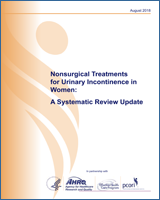From: Appendix H, Results of Subgroup Analyses by Type of UI

Nonsurgical Treatments for Urinary Incontinence in Women: A Systematic Review Update [Internet].
Comparative Effectiveness Review, No. 212.
Balk E, Adam GP, Kimmel H, et al.
Rockville (MD): Agency for Healthcare Research and Quality (US); 2018 Aug.
NCBI Bookshelf. A service of the National Library of Medicine, National Institutes of Health.